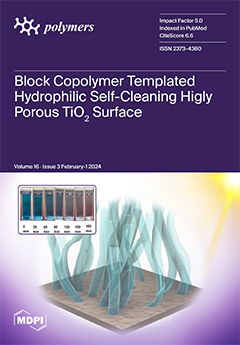Hyperbranched polymers (HBPs) are widely applied nowadays as functional materials for biomedicine needs, nonlinear optics, organic semiconductors, etc. One of the effective and promising ways to synthesize HBPs is a polyaddition of AB
2+A
2+B
4 monomers that is generated in
[...] Read more.
Hyperbranched polymers (HBPs) are widely applied nowadays as functional materials for biomedicine needs, nonlinear optics, organic semiconductors, etc. One of the effective and promising ways to synthesize HBPs is a polyaddition of AB
2+A
2+B
4 monomers that is generated in the A
2+CB
2, AA′+B
3, A
2+B′B
2, and A
2+C
2+B
3 systems or using other approaches. It is clear that all the foundational features of HBPs that are manufactured by a polyaddition reaction are defined by the component composition of the monomer mixture. For this reason, we have designed a structural kinetic model of AB
2+A
2+B
4 monomer mixture polyaddition which makes it possible to predict the impact of the monomer mixture’s composition on the molecular weight characteristics of hyperbranched polymers (number average (DP
n) and weight average (DP
w) degree of polymerization), as well as the degree of branching (DB) and gel point (p
g). The suggested model also considers the possibility of a positive or negative substitution effect during polyaddition. The change in the macromolecule parameters of HBPs formed by polyaddition of AB
2+A
2+B
4 monomers is described as an infinite system of kinetic equations. The solution for the equation system was found using the method of generating functions. The impact of both the component’s composition and the substitution effect during the polyaddition of AB
2+A
2+B
4 monomers on structural and molecular weight HBP characteristics was investigated. The suggested model is fairly versatile; it makes it possible to describe every possible case of polyaddition with various monomer combinations, such as A
2+AB
2, AB
2+B
4, AB
2, or A
2+B
4. The influence of each monomer type on the main characteristics of hyperbranched polymers that are obtained by the polyaddition of AB
2+A
2+B
4 monomers has been investigated. Based on the results obtained, an empirical formula was proposed to estimate the p
g = p
A during the polyaddition of an AB
2+A
2+B
4 monomer mixture: p
g = p
A = (−0.53([B]
0/[A]
0)
1/2 + 0.78)υAB
2 + (1/3)
1/2([B]
0/[A]
0)
1/2, where (1/3)
1/2([B]
0/[A]
0)
1/2 is the Flory equation for the A
2+B
4 polyaddition, [A]
0 and [B]
0 are the A and B group concentration from A
2 and B
4, respectively, and υAB
2 is the mole fraction of the AB
2 monomer in the mixture. The equation obtained allows us to accurately predict the p
g value, with an AB
2 monomer content of up to 80%.
Full article






